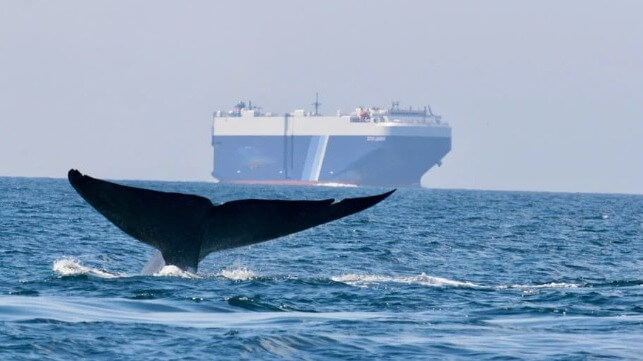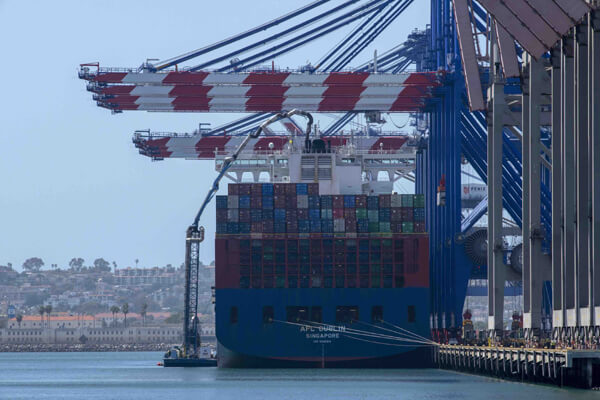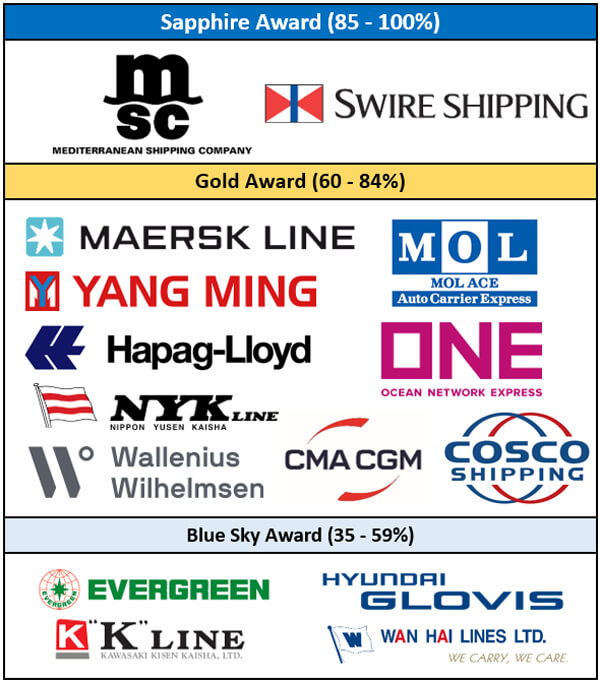Ships Reduced Speeds off California to Protect Blue Whales and Skies

“Protecting Blue Whales & Blue Skies” program announced results from an initiative to cut air pollution and protect endangered whales. Eighteen shipping companies participated in 2021, transiting at 10 knots or less in the San Francisco Bay Area and the Southern California region. The voluntary incentive program ran from May 15, 2021 through November 15, 2021.
Shipping companies receive recognition and financial awards based on the percent of distance traveled by their vessels through the Vessel Speed Reduction (VSR) zones at 10 knots or less and with an average speed of 12 knots or less. The 10-knot target complements the National Oceanic and Atmospheric Administration’s (NOAA) and U.S. Coast Guard’s requests for all vessels (300 gross tons or larger) to reduce speeds during the months of peak endangered blue, humpback, and fin whale abundance to protect these whales from ship strikes.

Two blue whales in Channel Islands National Marine Sanctuary. Photo: NOAA
Ship strikes are a major threat to whales globally and to the recovery of endangered blue, fin, and humpback whales in California waters. Reducing the risk of ship strikes is a major priority of NOAA, including NOAA’s West Coast national marine sanctuaries. Observed and documented deaths totaled 51 endangered whales from 2007-2021, and likely represent only a small fraction of the total number of ship strikes taking place annually.
The timing of the program also coincides with the season when ground-level ozone (smog) concentrations are typically high. The 10-knot target allows ships to travel at an efficient operating load using less fuel and producing less pollution.

Container ship at Port of Los Angeles. Photo: Robert Schwemmer
Three award tiers for participating companies are Sapphire (85-100% of fleet total distance in VSR zones traveled at 10 knots or less), Gold (60-84%), and Blue Sky (35-59%). Automatic Identification System (AIS) transponders on each ship transmit the ship’s speed and location; AIS data was analyzed for each fleet and the company’s performance was classified by tier. Companies that performed at the Gold or Sapphire level were awarded a financial incentive.

For the fourth year in a row, Mediterranean Shipping Company (MSC) notably achieved the Sapphire tier in the large fleet category. Swire Shipping achieved the Sapphire tier in the small fleet category. For their outstanding commitment, these two companies earned the Protecting Blue Whales and Blue Skies Whale Tail awards.
The VSR incentive program has expanded in scope and environmental benefits each year, including 2021, which marked the seventh year. Highlights for 2021:
• Of the nearly 280,000 nautical miles of ocean transited by all ships in the program, nearly 180,000 nautical miles were 10 knots or less, equivalent to traversing the circumference of the Earth more than eight times.
• Ships in the program transiting the southern California approximately 200-nautical-mile VSR zone traveled at 10 knots or less for 66% of the total miles traveled. This number has steadily increased season after season, showing increasing commitment by participating companies.
• In the 50-nautical-mile San Francisco Bay Area VSR zone, cooperation levels from participating companies remained fairly consistent compared to previous years, with a combined value of 60%.
• Shipping companies that participated in the 2021 program reduced their air pollutant emissions by 650 tons of NOx and 22,201 metric tons of regional GHGs. (For example, this equates to the GHG emissions from 4,784 passenger vehicles driven for one year.) These numbers represent approximately a 25% reduction in NOx pollution from the ships that participated in the program, as compared to baseline conditions.
• The transits of vessels participating in the VSR program posed approximately 50% less strike mortality risk to whales than if those vessels did not slow in cooperation with the program.
• Ships in the Sapphire, Gold, and Blue Sky award tiers had sound levels that were 5 dB per transit lower when compared to baseline source levels. With a reduction in noise pollution whales can likely communicate easier.
• Incentives ranged from $5,000 to $50,000 per company in the Gold and Sapphire award tiers.
Seven companies – MSC, COSCO Shipping Lines, Maersk, Ocean Network Express (ONE), Wallenius Wilhelmsen, Yang Ming, and Swire Shipping – generously declined or returned their financial incentive payment. Those funds will be reinvested in the program.
The program is a collaborative effort by Santa Barbara County Air Pollution Control District; Ventura County Air Pollution Control District; Bay Area Air Quality Management District; NOAA Channel Islands, Cordell Bank, and Greater Farallones national marine sanctuaries; The Volgenau Foundation; California Marine Sanctuary Foundation; National Marine Sanctuary Foundation; Greater Farallones Association; Environmental Defense Center; Point Blue Conservation Science; Starcrest Consulting; and Scripps Whale Acoustic Laboratory/Scripps Institution of Oceanography. The 2022 program runs from May 1 through December 15, 2022.
For more information, visit www.bluewhalesblueskies.org.
This feature is sponsored by Protecting Blue Whales & Blue Skies
The opinions expressed herein are the author's and not necessarily those of The Maritime Executive.
